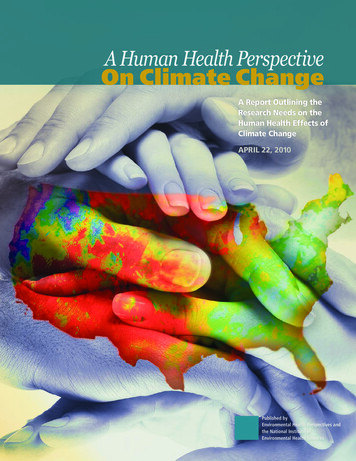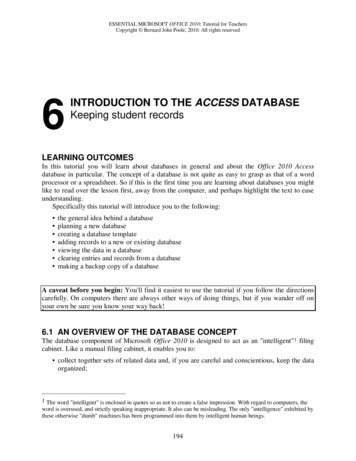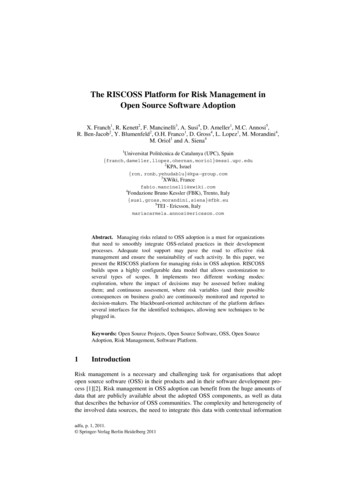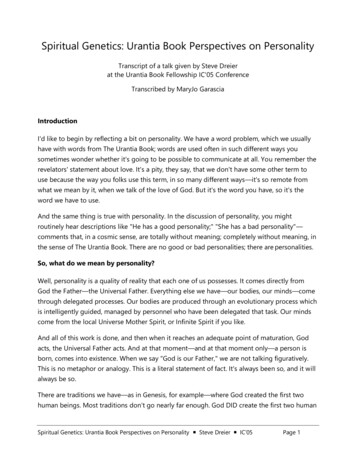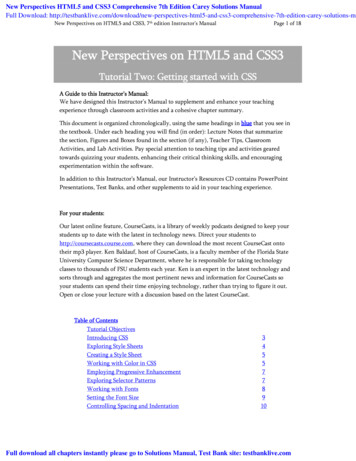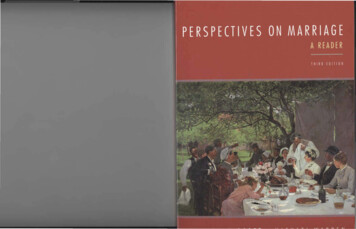
Transcription
PERSPECTIVES: AN OPEN INTRODUCTION TO CULTURALANTHROPOLOGYSECOND EDITIONNina Brown, Thomas McIlwraith, Laura Tubelle de González2020 American Anthropological Association2300 Clarendon Blvd, Suite 1301Arlington, VA 22201ISBN Print: 978-1-931303-67-5ISBN Digital: o.org/This book is a project of the Society for Anthropology in Community Colleges (SACC)http://sacc.americananthro.org/ and our parent organization, the American Anthropological Association(AAA). Please refer to the website for a complete table of contents and more information about thebook.
Perspectives: An Open Introduction to Cultural Anthropology by Nina Brown, Thomas McIlwraith, Laura Tubelle deGonzález is licensed under a Creative Commons Attribution-NonCommercial 4.0 International License, except whereotherwise noted.Under this CC BY-NC 4.0 copyright license you are free to:Share — copy and redistribute the material in any medium or formatAdapt — remix, transform, and build upon the materialUnder the following terms:Attribution — You must give appropriate credit, provide a link to the license, and indicate if changes were made. Youmay do so in any reasonable manner, but not in any way that suggests the licensor endorses you or your use.NonCommercial — You may not use the material for commercial purposes.
1INTRODUCTION TOANTHROPOLOGYKatie Nelson, Inver Hills Community ara Braff, Grossmont Collegelara.braff@gcccd.edu3
4PERSPECTIVES: AN OPEN INTRODUCTION TO CULTURAL ANTHROPOLOGYLearning Objectives Identify the four subfields of anthropology and describe the kinds of research projects associated with each subfield. Define culture and the six characteristics of culture. Describe how anthropology developed from early explorations of the world through the professionalization of the discipline inthe 19th century. Discuss ethnocentrism and the role it played in early attempts to understand other cultures. Explain how the perspectives of holism, cultural relativism, comparison, and fieldwork, as well as both scientific and humanistictendencies make anthropology a unique discipline. Evaluate the ways in which anthropology can be used to address current social, political, and economic issues.The first time I (Katie Nelson) heard the word anthropology, I was seventeen years old and sitting atthe kitchen table in my home in rural Minnesota. My mother was stirring a pot of chili on the stove.My dog was barking (again) at the squirrels outside. Her low bawl filtered through the screen door leftopen on the porch. It was the summer before I was to start college and I had a Macalester College coursecatalog spread out in front of me as I set about carefully selecting the courses that would make up myfall class schedule. When I applied to college, I had indicated in my application that I was interested instudying creative writing, poetry specifically. But I also had a passion for languages and people: observing people, interacting with people and understanding people, especially those who were culturally different from myself. I noticed a course in the catalog entitled “Cultural Anthropology.” I did not knowexactly what I would learn, but the course description appealed to me and I signed up for it. Severalweeks later, I knew what my major would be– anthropology!Like Katie, I (Lara Braff) started college with a curiosity about people but no clear major. In mysecond year, without knowing what anthropology was, I enrolled in an anthropology course called“Controlling Processes.” Throughout the semester, the professor encouraged us to question how socialinstitutions (like the government, schools, etc.) affect the ways we think and act. This inquiry resonatedwith my upbringing: my mother, who had immigrated to the United States in her twenties, often questioned U.S. customs that were unfamiliar to her. At times, this was profoundly disappointing to me as achild. For example, she could not understand the joyous potential of filling up on candy at Halloween, aholiday not celebrated in her country. Yet, her outsider perspective inspired in me a healthy skepticismabout things that others take to be “normal.” As I took more anthropology courses, I became intriguedby diverse notions of normality found around the world.If you are reading this textbook for your first anthropology course, you are likely wondering, muchlike we did, what anthropology is all about. Perhaps the course description appealed to you in some way,but you had a hard time articulating what exactly drove you to enroll. With this book, you are in theright place!
5WHAT IS ANTHROPOLOGY?Derived from Greek, the word anthropos means “human” and “logy” refers to the “study of.” Quite literally, anthropology is the study of humanity. It is the study of everything and anything that makes ushuman.1 From cultures, to languages, to material remains and human evolution, anthropologists examine every dimension of humanity by asking compelling questions like: How did we come to be humanand who are our ancestors? Why do people look and act so differently throughout the world? Whatdo we all have in common? How have we changed culturally and biologically over time? What factorsinfluence diverse human beliefs and behaviors throughout the world?You may notice that these questions are very broad. Indeed, anthropology is an expansive field ofstudy. It is comprised of four subfields that in the United States include cultural anthropology, archaeology, biological (or physical) anthropology, and linguistic anthropology. Together, the subfields providea multi-faceted picture of the human condition. Applied anthropology is another area of specializationwithin or between the anthropological subfields. It aims to solve specific practical problems in collaboration with governmental, non-profit, and community organizations as well as businesses and corporations.It is important to note that in other parts of the world, anthropology is structured differently. Forinstance, in the United Kingdom and many European countries, the subfield of cultural anthropologyis referred to as social (or socio-cultural) anthropology. Archaeology, biological anthropology, and linguistic anthropology are frequently considered to be part of different disciplines. In some countries, likeMexico, anthropology tends to focus on the cultural and indigenous heritage of groups within the country rather than on comparative research. In Canada, some university anthropology departments mirrorthe British social anthropology model by combining sociology and anthropology. As noted above, inthe United States and most commonly in Canada, anthropology is organized as a four-field discipline.You will read more about the development of this four-field approach in the Doing Fieldwork chapter(chapter three).WHAT IS CULTURAL ANTHROPOLOGY?The focus of this textbook is cultural anthropology, the largest of the subfields in the United Statesas measured by the number of people who graduate with PhDs each year.2 Cultural anthropologistsstudy the similarities and differences among living societies and cultural groups. Through immersivefieldwork, living and working with the people one is studying, cultural anthropologists suspend theirown sense of what is “normal” in order to understand other people’s perspectives. Beyond describinganother way of life, anthropologists ask broader questions about humankind: Are human emotions universal or culturally specific? Does globalization make us all the same, or do people maintain culturaldifferences? For cultural anthropologists, no aspect of human life is outside their purview. They studyart, religion, healing, natural disasters, and even pet cemeteries. While many anthropologists are at firstintrigued by human diversity, they come to realize that people around the world share much in common.Cultural anthropologists often study social groups that differ from their own, based on the view thatfresh insights are generated by an outsider trying to understand the insider point of view. For example,beginning in the 1960s Jean Briggs (1929-2016) immersed herself in the life of Inuit people in the cen-
6PERSPECTIVES: AN OPEN INTRODUCTION TO CULTURAL ANTHROPOLOGYtral Canadian arctic territory of Nunavut. She arrived knowing only a few words of their language, butready to brave sub-zero temperatures to learn about this remote, rarely studied group of people. In hermost famous book, Never in Anger: Portrait of an Eskimo Family (1970), she argued that anger and strongnegative emotions are not expressed among families that live together in small iglus amid harsh environmental conditions for much of the year. In contrast to scholars who see anger as an innate emotion,Briggs’ research shows that all human emotions develop through culturally specific child-rearing practices that foster some emotions and not others.While cultural anthropologists traditionally conduct fieldwork in faraway places, they are increasingly turning their gaze inward to observe their own societies or subgroups within them. For instance,in the 1980s, American anthropologist Philippe Bourgois sought to understand why pockets of extremepoverty persist amid the wealth and overall high quality of life in the United States. To answer thisquestion, he lived with Puerto Rican crack dealers in East Harlem, New York. He contextualized theirexperiences both historically in terms of their Puerto Rican roots and migration to the U.S. and inthe present as they experienced social marginalization and institutional racism. Rather than blame thecrack dealers for their poor choices or blame our society for perpetuating inequality, he argued thatboth individual choices and social structures can trap people in the overlapping worlds of drugs andpoverty (Bourgois 2003). For more about Bourgois, please see the interview with him in the learningresources, Anthropology in Our Moment in History.WHAT IS CULTURE?Cultural anthropologists study all aspects of culture, but what exactly is “culture”? When we (theauthors) first ask students in our introductory cultural anthropology courses what culture means tothem, our students typically say that culture is food, clothing, religion, language, traditions, art, music,and so forth. Indeed, culture includes many of these observable characteristics, but culture is also something deeper. Culture is a powerful defining characteristic of human groups that shapes our perceptions, behaviors, and relationships.One reason that culture is difficult to define is that it encompasses all the intangible qualities thatmake people who they are. Culture is the “air we breathe:” it sustains and comprises us, yet we largelytake it for granted. We are not always consciously aware of our own culture.Furthermore, cultural anthropologists themselves do not always agree on what culture is. In definingculture, some anthropologists emphasize material life and objects (e.g. tools, clothing, and technologies);others emphasize culture as a system of intangible beliefs; and still others focus on practices or customsof daily life. We propose a broad definition of culture.3Culture is a set of beliefs, practices, and symbols that are learned and shared. Together, they form an all-encompassing, integrated whole thatbinds people together and shapes their worldview and lifeways.To say that a group of people shares a culture does not mean all individuals think or act in identicalways. One’s beliefs and practices can vary within a culture depending on age, gender, social status, andother characteristics. Yet, members of a culture share many things in common. While we are not bornwith a particular culture, we are born with the capacity to learn any culture. Through the process ofenculturation, we learn to become members of our group both directly, through instruction from ourparents and peers, and indirectly by observing and imitating those around us.
7Culture constantly changes in response to both internal and external factors. Some parts of culturechange more quickly than others. For instance, in dominant American culture, technology changesrapidly while deep seated values such as individualism, freedom, and self-determination change verylittle over time. Yet, inevitably, when one part of culture changes, so do other parts. This is becausenearly all parts of a culture are integrated and interrelated. As powerful as culture is, humans are notnecessarily bound by culture; they have the capacity to conform to it or not and even transform it.In the definition above, belief refers not just to what we “believe” to be right or wrong, true or false.Belief also refers to all the mental aspects of culture including values, norms, philosophies, worldview,knowledge, and so forth. Practices refers to behaviors and actions that may be motivated by belief orperformed without reflection as part of everyday routines.Much like art and language, culture is also symbolic. A symbol is something that stands for somethingelse, often without a natural connection. Individuals create, interpret, and share the meanings of symbols within their group or the larger society. For example, in U.S. society everyone recognizes a redoctagonal sign as signifying “stop.” In other cases, groups within American society interpret the samesymbol in different ways. Take the Confederate flag: Some people see it as a symbol of pride in a southern heritage. Many others see it as a symbol of the long legacy of slavery, segregation, and racial oppression. Thus, displaying the Confederate flag could have positive or, more often, negative connotations.Cultural symbols powerfully convey either shared or conflicting meanings across space and time.This definition of culture – shared, learned beliefs, practices, and symbols – allows us to understandthat people everywhere are thinkers and actors shaped by their social contexts. As we will see throughout this book, these contexts are incredibly diverse, comprising the human cultural diversity that drewmany of us to become anthropologists in the first place.While culture is central to making us human, we are still biological beings with natural needs andurges that we share with other animals: hunger, thirst, sex, elimination, etc. Human culture uniquelychannels these urges in particular ways and cultural practices can then impact our biology, growth, anddevelopment. Humans are one of the most dynamic species on Earth. Our ability to change both culturally and biologically has enabled us to persist for millions of years and to thrive in diverse environments.Characteristics of CultureCulture is a set of beliefs, practices, and symbols that are learned and shared. Together, they form an all-encompassing, integrated wholethat binds groups of people together and shapes their worldview and lifeways. Additionally:1.Humans are born with the capacity to learn the culture of any social group. We learn culture both directly and indirectly.2.Culture changes in response to both internal and external factors.3.Humans are not bound by culture; they have the capacity to conform to it or not, and sometimes change it.4.Culture is symbolic; individuals create and share the meanings of symbols within their group or society.5.The degree to which humans rely on culture distinguishes us from other animals and shaped our evolution.6.Human culture and biology are interrelated: Our biology, growth, and development are impacted by culture.A BRIEF HISTORY OF ANTHROPOLOGICAL THINKING
8PERSPECTIVES: AN OPEN INTRODUCTION TO CULTURAL ANTHROPOLOGYImagine you are living several thousand years ago. Maybe you are a wife and mother of three children. Maybe you are a young man eager to start your own family. Maybe you are a prominent religiousleader, or maybe you are a respected healer. Your family has, for as long as people can remember, livedthe way you do. You learned to act, eat, hunt, talk, pray, and live the way you do from your parents, yourextended family, and your small community. Suddenly, you encounter a new group of people who havea different way of living, speak strangely, and eat in an unusual manner. They have a different way ofaddressing the supernatural and caring for their sick. What do you make of these differences? These arethe questions that have faced people for tens of thousands of years as human groups have moved aroundand settled in different parts of the world.One of the first examples of someone who attempted to systematically study and document cultural differences is Zhang Qian(164 BC – 113 BC). Born in the second century BCE in Hanzhong,China, Zhang was a military officer who was assigned by EmperorWu of Han to travel through Central Asia, going as far as what istoday Uzbekistan. He spent more than twenty-five years travelingand recording his observations of the peoples and cultures of Central Asia (Wood 2004). The Emperor used this information toestablish new relationships and cultural connections with China’sneighbors to the West. Zhang discovered many of the trade routesused in the Silk Road and introduced several new cultural ideas,including Buddhism, into Chinese culture.Another early traveler of note was Abu Abdullah MuhammadIbn Battuta, known most widely as Ibn Battuta, (1304-1369). IbnBattuta was an Amazigh (Berber) Moroccan Muslim scholar. During the fourteenth century, he traveled for a period of nearly thirtyyears, covering almost the whole of the Islamic world, includingFigure 1: Statue of Zhang Qian in Chenggu, China.parts of Europe, sub-Saharan Africa, India, and China. Upon hisZhang Qian is still celebrated today in China as animportant diplomat and pioneer of the silk road. Imagereturn to the Kingdom of Morocco, he documented the customscourtesy of Judy Wells and Debi Landerand traditions of the people he encountered in a book called Tuhfatal-anzar fi gharaaib al-amsar wa ajaaib al-asfar (A Gift to those who Contemplate the Wonders of Cities and theMarvels of Traveling), a book commonly known as Al Rihla, which means “travels” in Arabic (Mackintosh-Smith 2003: ix). This book became part of a genre of Arabic literature that included descriptionsof the people and places visited along with commentary about the cultures encountered. Some scholarsconsider Al Rihla to be among the first examples of early pre-anthropological writing.4
9Later, from the 1400s through the1700s, during the so-called “Age ofDiscovery,” Europeans began to explore the world, and then colonize it.Europeans exploited natural resources and human labor in other parts ofthe world, exerting social and political control over the people theyencountered. New trade routes along with the slave trade fueled a growingEuropean empire while forever disrupting previously independent cultures in the Old World. European ethnocentrism—the belief that one’sown culture is better than others—was used to justify the subjugation ofnon-European societies on the alleged basis that these groups were sociallyFigure 2. An illustration of Abu Abdullahand even biologically inferior. Indeed, the emerging anthropological pracMuhammad Ibn Battuta in Egypt fromJules Verne’s book “Découverte de latices of this time were ethnocentric and often supported colonial projects.terre” (Discovery of the Earth).As European empires expanded, new ways of understanding the worldand its people arose. Beginning in the eighteenth century in Europe, theAge of the Enlightenment was a social and philosophical movement that privileged science, rationality,and experience, while critiquing religious authority. This crucial period of intellectual developmentplanted the seeds for many academic disciplines, including anthropology. It gave ordinary people thecapacity to learn the “truth” through observation and experience: anyone could ask questions and userational thought to discover things about the natural and social world.For example, geologist Sir Charles Lyell (1797-1875) observed layers ofrock and argued that the earth’s surface must have changed gradually overlong periods of time. He disputed the Young Earth theory, which was popular at the time and used Biblical information to date the earth as only6,000 years old, Charles Darwin (1809-1882), a naturalist and biologist,observed similarities between fossils and living specimens, leading him toargue that all life is descended from a common ancestor. Philosopher JohnLocke (1632-1704) contemplated the origins of society itself, proposingthat people historically had lived in relative isolation until they agreed toFigure 3: Charles Darwin in 1854, fiveform a society in which the government would protect their personal propyears before he published The Origin ofSpecies.erty.These radical ideas about the earth, evolution, and society influencedearly social scientists into the nineteenth century. Philosopher and anthropologist Herbert Spencer(1820-1903), inspired by scientific principles, used biological evolution as a model to understand socialevolution. Just as biological life evolved from simple to complex multicellular organisms, he postulatedthat societies “evolve” to become larger and more complex. Anthropologist Lewis Henry Morgan(1818-1881) argued that all societies “progress” through the same stages of development: savagery—barbarism—civilization. Societies were classified into these stages based on their family structure, technologies, and methods for acquiring food. So-called “savage” societies, ones that used stonetools and foraged for food, were said to be stalled in their social, mental, and even moral development.Ethnocentric ideas like Morgan’s were challenged by anthropologists in the early twentieth centuryin both Europe and the United States. During World War I, Bronislaw Malinowski (1884-1942), a Polishanthropologist, became stranded on the Trobriand Islands located north of Australia and Papua NewGuinea. While there, he started to develop participant-observation fieldwork: the method of immersive, long-term research that cultural anthropologists use today. By living with and observing the Trobriand Islanders, he realized that their culture was not “savage,” but was well-suited to fulfill the needsof the people. He developed a theory to explain human cultural diversity: each culture functions to sat-
10PERSPECTIVES: AN OPEN INTRODUCTION TO CULTURAL ANTHROPOLOGYisfy the specific biological and psychological needs of its people. While this theory has been critiqued asbiological reductionism, it was an early attempt to view other cultures in more open-minded ways.Around the same time in the United States, Franz Boas (1858-1942),widely regarded as the founder of American anthropology, developed cultural relativism, the view that while cultures differ, they are not better orworse than one another. In his critique of ethnocentric views, Boas insistedthat physical and behavioral differences among racial and ethnic groups inthe United States were shaped by environmental and social conditions, notbiology. In fact, he argued that culture and biology are distinct realms ofexperience: human behaviors are socially learned, contextual, and flexible,not innate. Further, Boas worked to transform anthropology into a profesFigure 4: Franz Boas, circa 1915.sional and empirical academic discipline that integrated the four subdisciplines of cultural anthropology, linguistic anthropology, archaeology, andbiological anthropology.THE (OTHER) SUBFIELDS OF ANTHROPOLOGYFigure 5: Anthropology and Its Subfields. Image by Katie Nelson.Biological AnthropologyBiological anthropology is the study of human origins, evolution, and variation. Some biologicalanthropologists focus on our closest living relatives, monkeys and apes. They examine the biologicaland behavioral similarities and differences between nonhuman primates and human primates (us!). Forexample, Jane Goodall has devoted her life to studying wild chimpanzees (Goodall 1996). When shebegan her research in Tanzania in the 1960s, Goodall challenged widely held assumptions about theinherent differences between humans and apes. At the time, it was assumed that monkeys and apeslacked the social and emotional traits that made human beings such exceptional creatures. However,Goodall discovered that, like humans, chimpanzees also make tools, socialize their young, have intense
11emotional lives, and form strong maternal-infant bonds. Her work highlights the value of field-basedresearch in natural settings that can help us understand the complex lives of nonhuman primates.Other biological anthropologists focus onextinct human species, asking questions like: Whatdid our ancestors look like? What did they eat?When did they start to speak? How did they adaptto new environments? In 2013, a team of womenscientists excavated a trove of fossilized bones inthe Dinaledi Chamber of the Rising Star Cave system in South Africa. The bones turned out tobelong to a previously unknown hominin speciesthat was later named Homo naledi. With over 1,550specimens from at least fifteen individuals, the siteis the largest collection of a single hominin speciesfound in Africa (Berger, 2015). Researchers are stillFigure 6: Chimpanzees are the nonhuman primate that are most closely related toworking to determine how the bones were left inhumans. We shared a common ancestor with Chimpanzees around 8 millionyears ago.the deep, hard to access cave and whether or notthey were deliberately placed there. They also wantto know what Homo naledi ate, if this species made and used tools, and how they are related to otherHomo species. Biological anthropologists who study ancient human relatives are called paleoanthropologists. The field of paleoanthropology changes rapidly as fossil discoveries and refined dating techniques offer new clues into our past.Other biological anthropologists focus onhumans in the present including their genetic andphenotypic (observable) variation. For instance,Nina Jablonski has conducted research on humanskin tone, asking why dark skin pigmentation isprevalent in places, like Central Africa, wherethere is high ultraviolet (UV) radiation from sunlight, while light skin pigmentation is prevalent inplaces, like Nordic countries, where there is lowUV radiation. She explains this pattern in terms ofthe interplay between skin pigmentation, UV radiation, folic acid, and vitamin D. In brief, too muchUV radiation can break down folic acid, which isFigure 7: Human skin color ranges from dark brown to light pink.essential to DNA and cell production. Dark skinhelps block UV, thereby protecting the body’s folicacid reserves in high-UV contexts. Light skin evolved as humans migrated out of Africa to low-UV contexts, where dark skin would block too much UV radiation, compromising the body’s ability to absorbvitamin D from the sun. Vitamin D is essential to calcium absorption and a healthy skeleton. Jablonski’sresearch shows that the spectrum of skin pigmentation we see today evolved to balance UV exposurewith the body’s need for vitamin D and folic acid ( Jablonski 2012).Archaeology
12PERSPECTIVES: AN OPEN INTRODUCTION TO CULTURAL ANTHROPOLOGYArchaeologists focus on the material past: the tools, food, pottery, art, shelters, seeds, and otherobjects left behind by people. Prehistoric archaeologists recover and analyze these materials to reconstruct the lifeways of past societies that lacked writing. They ask specific questions like: How did peoplein a particular area live? What did they eat? Why did their societies to change over time? They also askgeneral questions about humankind: When and why did humans first develop agriculture? How didcities first develop? How did prehistoric people interact with their neighbors?The method that archaeologists use to answertheir questions is excavation—the careful diggingand removing of dirt and stones to uncover material remains while recording their context. Archaeological research spans millions of years fromhuman origins to the present. For example, Britisharchaeologist Kathleen Kenyon (1906-1978), wasone of few female archaeologists in the 1940s. Shefamously studied the city structures and cemeteries of Jericho, an ancient city dating back to theEarly Bronze Age (3,200 years before the present)located in what is today the West Bank. Based onher findings, she argued that Jericho is the oldestFigure 8: Archaeologists, including Kathleen Kenyon, have helped unearth thecity in the world and has been continuously occufoundations of ancient dwellings at Jericho.pied by different groups for over 10,000 years(Kenyon 1979).Historical archaeologists study recent societies using material remains to complement the writtenrecord. The Garbage Project, which began in the 1970s, is an example of a historic archaeological project based in Tucson, Arizona. It involves excavating a contemporary landfill as if it were a conventionalarchaeology site. Archaeologists have found discrepancies between what people say they throw out andwhat is actually in their trash. In fact, many landfills hold large amounts of paper products and construction debris (Rathje and Murphy 1992). This finding has practical implications for creating environmentally sustainable waste disposal practices.In 1991, while working on an office building in New York City, construction workers came acrosshuman skeletons buried just 30 feet below the city streets. Archaeologists were called in to investigate.Upon further excavation, they discovered a six-acre burial ground, containing 15,000 skeletons of freeand enslaved Africans who helped build the city during the colonial era. The “African Burial Ground,”which dates dating from 1630 to 1795, contains a trove of information about how free and enslavedAfricans lived and died. The site is now a national monument where people can learn about the historyof slavery in the U.S.5Linguistic AnthropologyLanguage is a defining trait of human beings. While
The focus of this textbook is cultural anthropology, the largest of the subfields in the United States . as measured by the number of people who graduate with PhDs each year. 2. Cultural anthropologists study the similarities and differences amon

